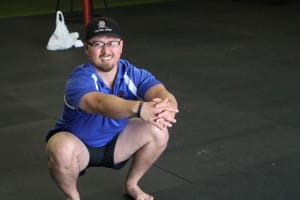“My hips are tight. Can we stretch first?”
 Tight hips are probably 1 of my top 3 conversation topics for personal training sessions. They are up right along with people trying to explain Game of Thrones (I’ve never seen an episode) and others asking me when I’m going to shave my mustache.
Tight hips are probably 1 of my top 3 conversation topics for personal training sessions. They are up right along with people trying to explain Game of Thrones (I’ve never seen an episode) and others asking me when I’m going to shave my mustache.
I’ll probably never watch Game of Thrones and the mustache is staying for some time. However, tight hips are something I can definitely help with.
Most people experiencing stiff/tight hips has to do more with mobility than flexibility.
Wait, what’s the difference between flexibility and mobility?
Flexibility is how much range of motion you have through passive movement. Basically, how far I can move your leg without you helping me.
Mobility is how much range of motion you have control over. So, without any help, how far can you move your leg.
Got it, back to tight hips…
While it’s beneficial to work on both flexibility AND mobility. The application of one or the other plays an important role in helping you move better.
Flexibility, generally, are long steady hold type exercises (i.e the classic toe touch hold for 30 seconds) that are supposed to lengthen tissue. How much that tissue lengthens is arguably due to the many factors in effect. During a stretch, muscle tissue is being lengthened, as well as connective tissue, and there may be general tension being eased due to the nervous system relaxing. The ability to maintain this post stretch is also argued across the internet because everyone responds a bit differently.
Basically, stretching is good for you and you need to do it. EVERY DAY, but preferably not right before your strength training. Why? As you lengthen the muscle through a static stretch (we’re still talking about flexibility here) you lose some tension and ability to contract fully. This could reduce the strength of the muscle and increase the risk of injury when using heavier weights.
Ultimately though, you know your body best and maybe light stretching as part of your warm-up makes you feel like Thor when he got his new hammer. Go for it!
Mobility exercises work a bit different. Generally, they are more dynamic. They’re friendlier, tell funny jokes, engage in a conversation with you and pick up the tab…jk. Dynamic movement refers to the ability to take joints and limbs through their range of motion by voluntarily moving them.
Instead of being passive and letting the tissue lengthen via gravity, and forcing the neural tension to subside through forced surrender, you work back and forth using concentric (shortening) and eccentric (stretch) muscle movement to create a synergistic medley of an active stretch, muscular warm up, and increased range of motion.
It sounds super complicated and it really doesn’t have to to be. The basics of mobility work:
- Take a specific movement(i.e squat) or a joint (i.e. hip).
- Move it safely through its’ range of motion, all the movement you can think of. Start slow and build up. Don’ make it painful.
- Repeat.
These bottom videos I shot to focus on mobility for tight hips. Try them out and apply the principles to other movements, joints, and/or areas of your liking.
Quad and Hamstring Rocking
Begin on your hands and knees, then extend one leg forward and rocks forward and backward. Do 10-15 reps on each side.
Hip mobility: Adductor rocking
Begin on your hands and knees, then extend one leg out to the side and rocks forward and backward. Do 10-15 reps on each side.
Hip Mobility: External rotation
Begin in a modified pigeon position, keeping a straight back fold over your hip and feel the stretch in your glutes as you move back and forth.
Let me know how this is working for you.
